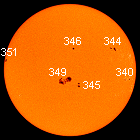A massive explosion on the sun's surface has triggered the largest solar radiation storm since 2005, hurling charged particles at Earth. (NASA / May 4, 2012)
Posted on 05/05/2012 7:09:10 PM PDT by null and void
A massive explosion on the sun's surface has triggered the largest solar radiation storm since 2005, hurling charged particles at Earth. (NASA / May 4, 2012)
A stream of highly charged particles from the sun is headed straight toward Earth, threatening to plunge cities around the world into darkness and bring the global economy screeching to a halt.
This isn't the premise of the latest doomsday thriller. Massive solar storms have happened before — and another one is likely to occur soon, according to Mike Hapgood, a space weather scientist at the Rutherford Appleton Laboratory near Oxford, England.
Much of the planet's electronic equipment, as well as orbiting satellites, have been built to withstand these periodic geomagnetic storms. But the world is still not prepared for a truly damaging solar storm, Hapgood argues in a recent commentary published in the journal Nature.
Hapgood talked with The Times about the potential effects of such a storm and how the world should prepare for it.
We had a recent flare-up of publicity in March thanks to a solar storm that didn't really amount to much. Is this sort of coverage a good thing or a bad thing?
It makes such a good scare story, and it's entertaining. It was a mildly interesting event, certainly, but not at all big-league stuff. It makes people think, "Oh it's nothing really," so experts like myself are in danger of being in the crying-wolf situation. That's something that is a concern to me, personally.
(Excerpt) Read more at latimes.com ...
But charged particles don't travel at the speed of light. Much slower.
I don't believe that's correct. Solar flares are associated with sunspots, and sunspot size correlates to the size and strength of the associated magnetic fields and therefore potential flare strength. Large sunspots are just as likely (as far as size distribution) when the sun is highly active, and there tend to be more of them.
Here's an image from May 1, 2003, during the peak of Cycle 23, a fairly active cycle. Note the very large sunspot near the middle of the solar disc. It's many times Earth-size.

You can read the archived spaceweather.com page here. It discusses the flare potential for those spots.
I found this interesting paper on solar storms. It contains a table of "great solar storms", and while the 1859 event was during a low cycle, many of the others were during very active cycles.
What is true is that low cycles like 24 and (most likely) 25 can still produce large sunspots, and severe solar weather.
For those interested in comparing the current solar cycle with historical data, I recommend keeping an eye on the Layman's Sunspot Count. Despite the name, it's a very professional attempt to compare current solar activity with activity during the Maunder and Dalton minima - something the "official" counts are doing poorly.
Oh, come on.
We’re supposed to believe that massive solar flares will cause communications to be cut off in the mi
If you look at your interesting paper, nearly every very large event, > 1000 nT, occurred with sunspot counts of around 100 or less.
Fresh Wind ~ These seem to have been replaced by "Obama is straight" stories lately.
*ouch*
I actually didn't see sunspot count presented as part of that data. However, if you look at page five of this paper, it does have a nice plot of severe geomagnetic storms versus sunspot cycle. That data directly contradicts your hypothesis, as in four out of five cases the largest storms occurred at or near the peak of active cycles. The second largest storm occurred right at the peak of Cycle 22, when sunspot counts were around 200.
I'd be interested in any papers you can reference that came to the conclusion that the largest storms are likelier during weak cycles and/or low activity. It is a contention of the paper that I referenced above that the peak for solar storm activity comes somewhat after cycle maximum, however that says nothing about the distribution of the largest storms. Also I think this paper is referencing CIR storms as opposed to CME storms.
bflr

Are you forgetting Elijah?
Yes, I had.
I’m pretty pale. Do you have SPF 1,000?
“We can all thank God for giving us a planet that’s been around for about 4.6 billion years ... with no end in sight.”
Oh, man - we’re overdue!
Coming right up!
“ARe wE DEAd yeT?????
/Can’’t tell becAUSe of WHat I’m sMOKin.....
LET me know.”
THEY KILLED KENNY!
I've seen that before, it's mold on a block of cheese....
“There was a solar storm back in the mid to late 1800’s that fused telegraph devices...a similar storm today would do far more damage and it’s only a matter of time.”
But, we’ll still be able to use the Internet, right?
We’ll still be able to post on Free Republic, right?
So, Romney better damn well win!
We've already had a 4-year catastrophe...
“ha ha to you, sun!”
How about that, sun.
What do you say about that, stupid?
“We’re supposed to believe that massive solar flares will cause communications to be cut off in the mi...”
That’s what I was thi
Careful citizen. Big Solar doesn't like such talk.
Disclaimer: Opinions posted on Free Republic are those of the individual posters and do not necessarily represent the opinion of Free Republic or its management. All materials posted herein are protected by copyright law and the exemption for fair use of copyrighted works.